Trek Grade
Challenging
Highest Altitude
6456 mtr
Base Camp
Gangotri
Best Time
Sept - Mid Oct
Mt Jogin 3 Expedition
The peaks within the Gangotri valley within the Garhwal Himalayas situated in Uttarakhand, Mount Jogin I and Mount Jogin 3 are awe-inspiring mountains. The altitude of Jogin 3 is 6,116 meters (20,066 feet) and makes the highest peak in the world, 155th, entirely within Uttarakhand. The difficult trek to the base camp in Kedar Tal offers breathtaking views of the lake and Thalisagar, enthralling climbers with breathtaking views. This expedition requires technical climbing over the base camp, allowing climbers to summit two peaks in a row. Its base camp is situated in Kedar Tal, which is located at 4780 meters above sea level. There is an advanced base camp located at 5150 meters. Camp I is Camp I at 5470 meters, Summit Camp at 5780 meters and the two summits with 6,116 meters and 6,456 metres.
The huge area around it is protected by the expansive 2,390-km Gangotri National Park, one of India’s most extensive conservation areas. The national park has a range of famous trekking routes, including Gangotri Gomukh Tapovan Nandanvan Kedarnath Vasuki Tal Trek, Har Ki Doon Valley Trek, Badrinath to Satopanth Tal Trek, Gangotri to Kedar Tal Trek, Gangotri to Badrinath Trek Kalindi Khal, among others. Additionally, in June 1967, Dr. G.R. Patwardhan led a group that completed the first climb of Jogin III.
Despite the difficulties, the Jogin Expedition has remained a top choice for trekkers and climbers because of the region’s stunning natural beauty and the thrill of reaching a Himalayan peak. It also allows one to fully immerse oneself in the natural world and discover the Uttarakhand people’s unique way of life and customs.
Trek Cost
- Stay will be on a twin-sharing basis in tents
- + 210 Trek Insurance (optional)
- Discount Policy
Pickup time 6.30 A.M from Dehradun.
Fix Diparture Dates
Mt Jogin 3 Expedition Videos
Videos by experts watch these videos to prepare well for a Successful Trek

Want To Trek Like Pro?
Check out the following videos if you want to trek like a pro trekker and improve your skills. These videos contain helpful tips, tricks, and techniques to help you trek like a pro. Whether you’re a beginner or an experienced trekker, these videos can provide valuable insights to enhance your trekking experience. So, watch the videos below by Trekup India experts to take your trekking skills to the next level.
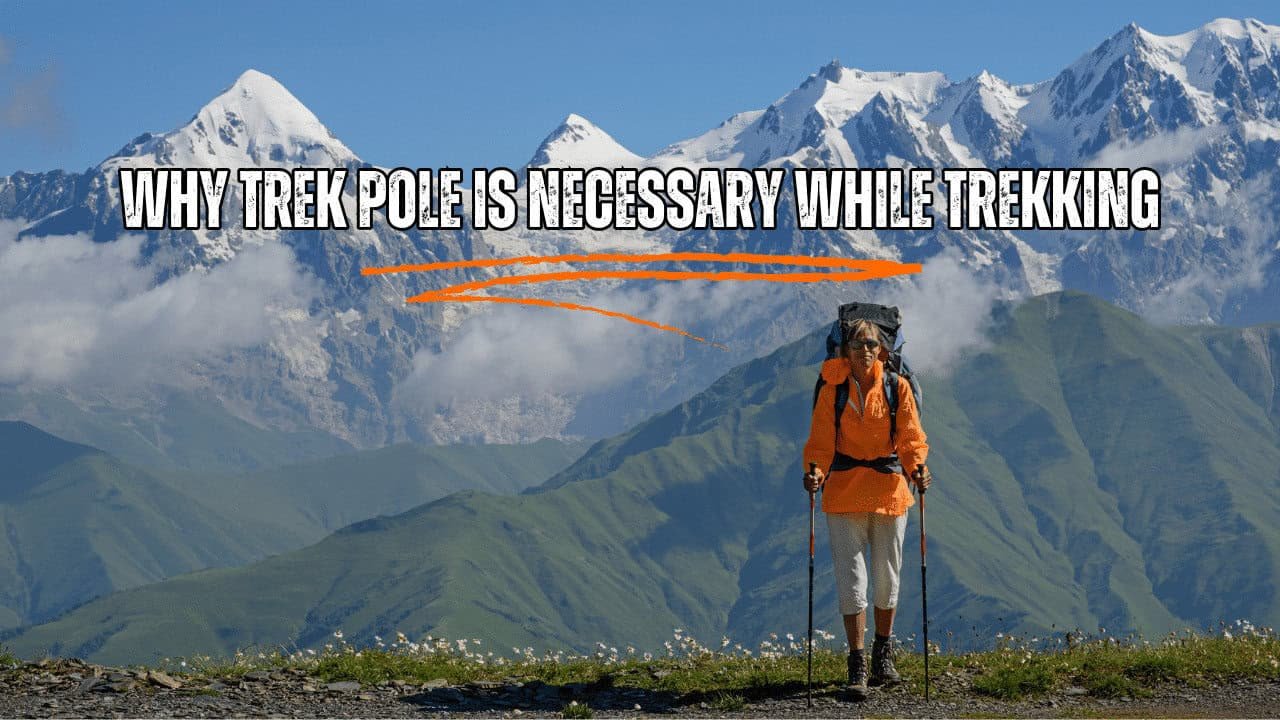
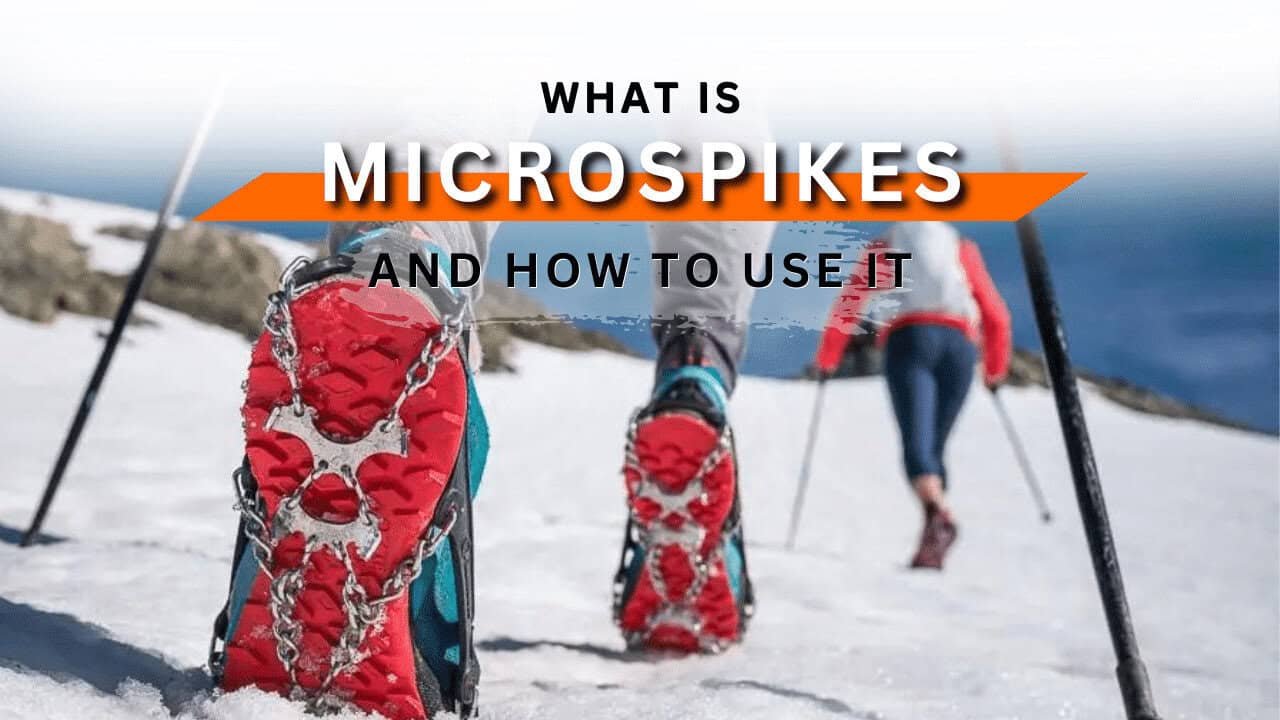
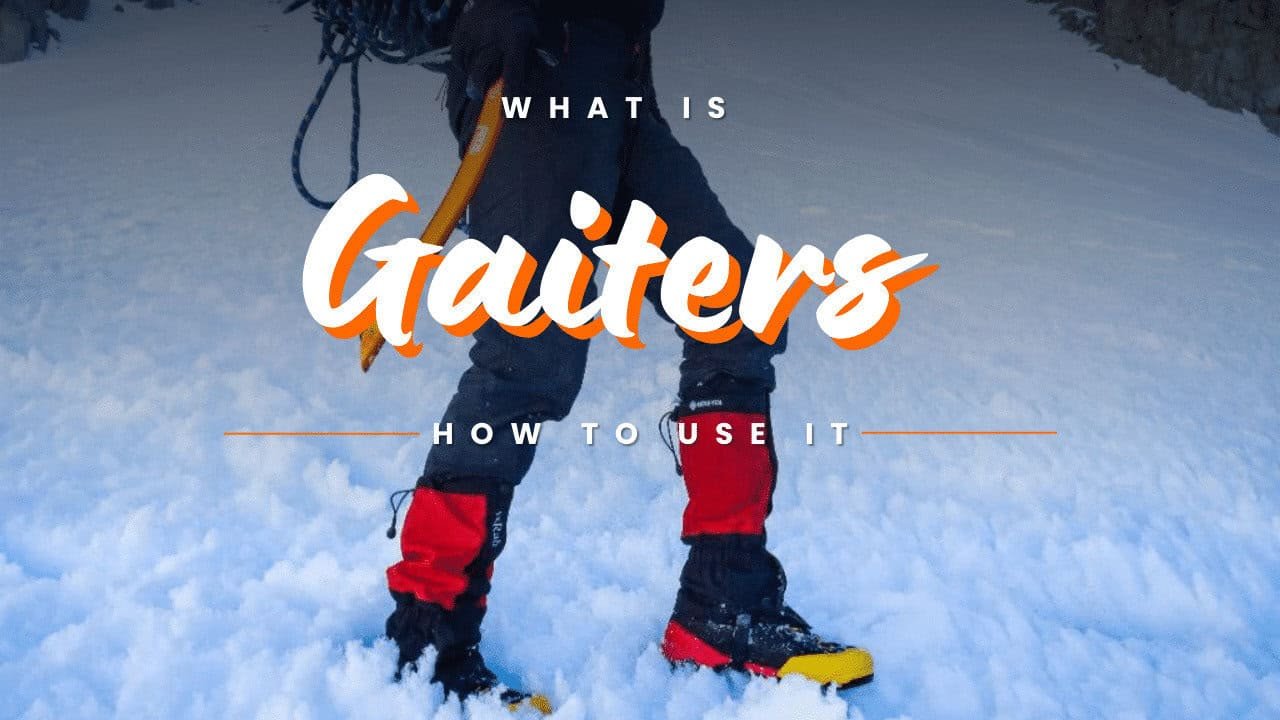
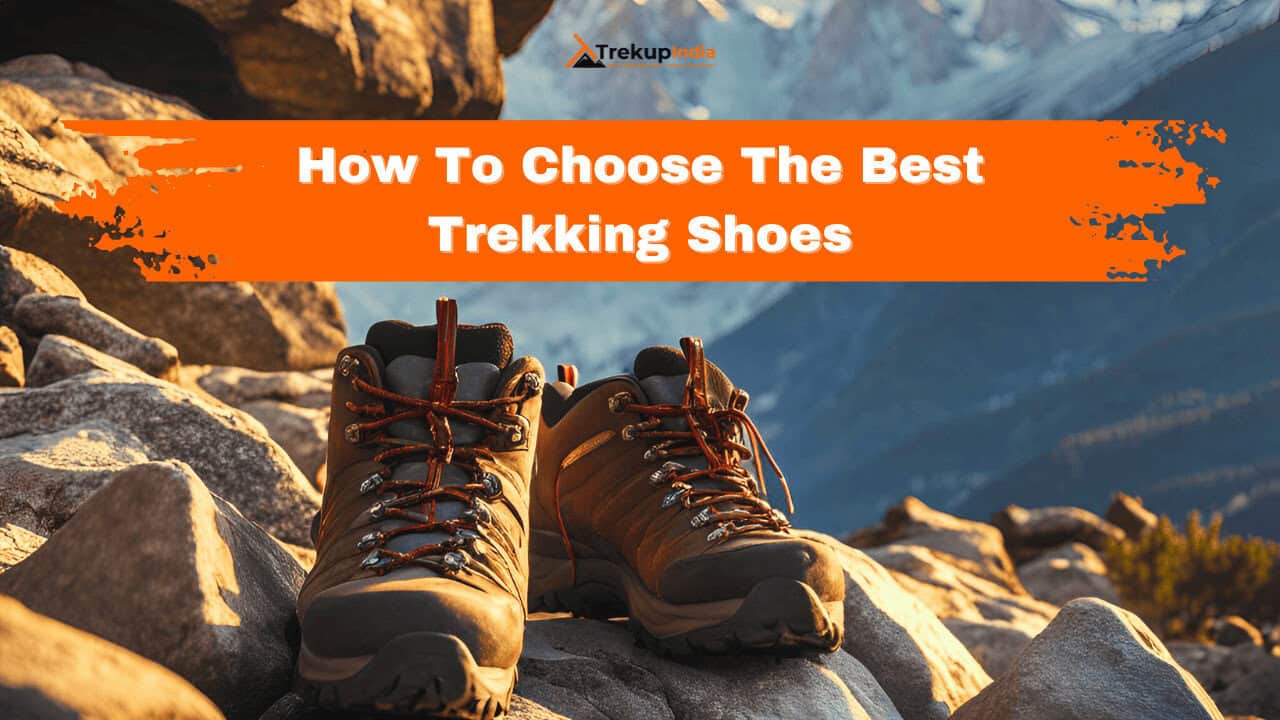

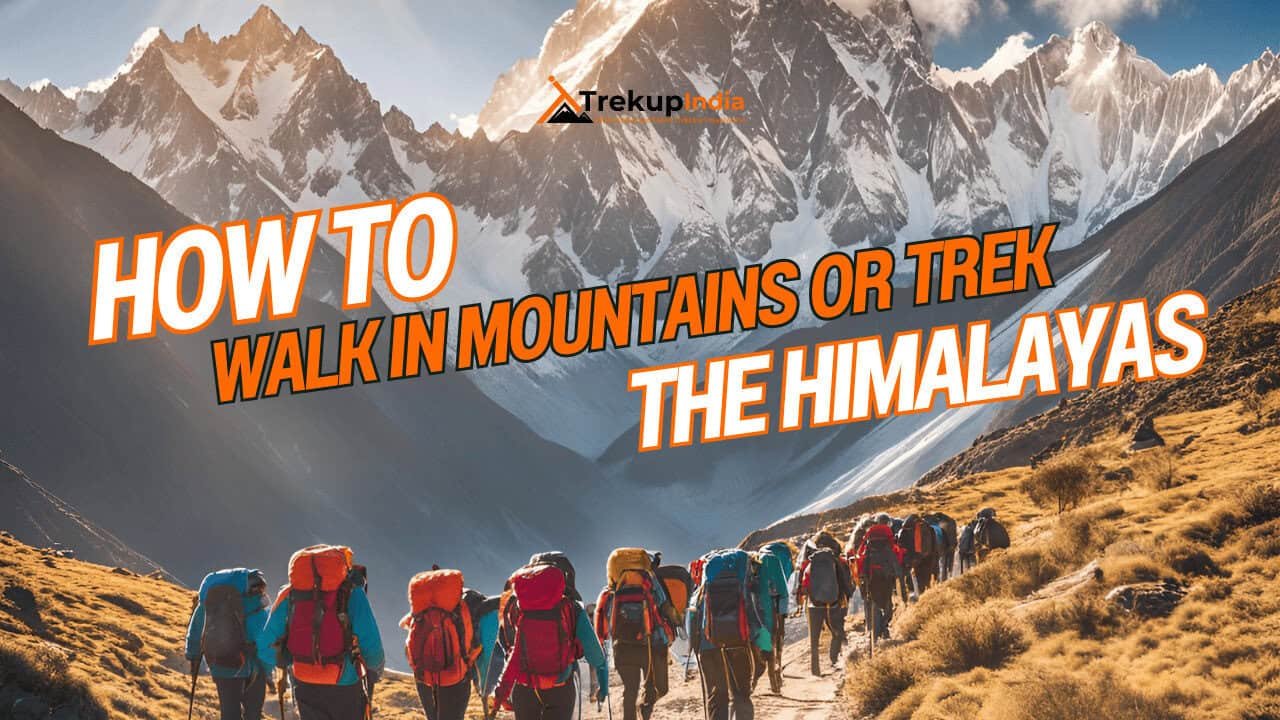

Know Everything About Acute Mountain Sickness
Acute Mountain Sickness is a medical condition that can occur when individuals travel to high altitudes, typically above 8,000 feet. It is caused by the decrease in air pressure and oxygen levels in the air as altitude increases. Symptoms of Acute Mountain Sickness may include headache, nausea, vomiting, dizziness, and difficulty sleeping. To avoid Acute Mountain Sickness, it is important to gradually adjust to high altitudes and seek medical attention if symptoms worsen. To learn more about this condition, check out the videos by Trekup India.
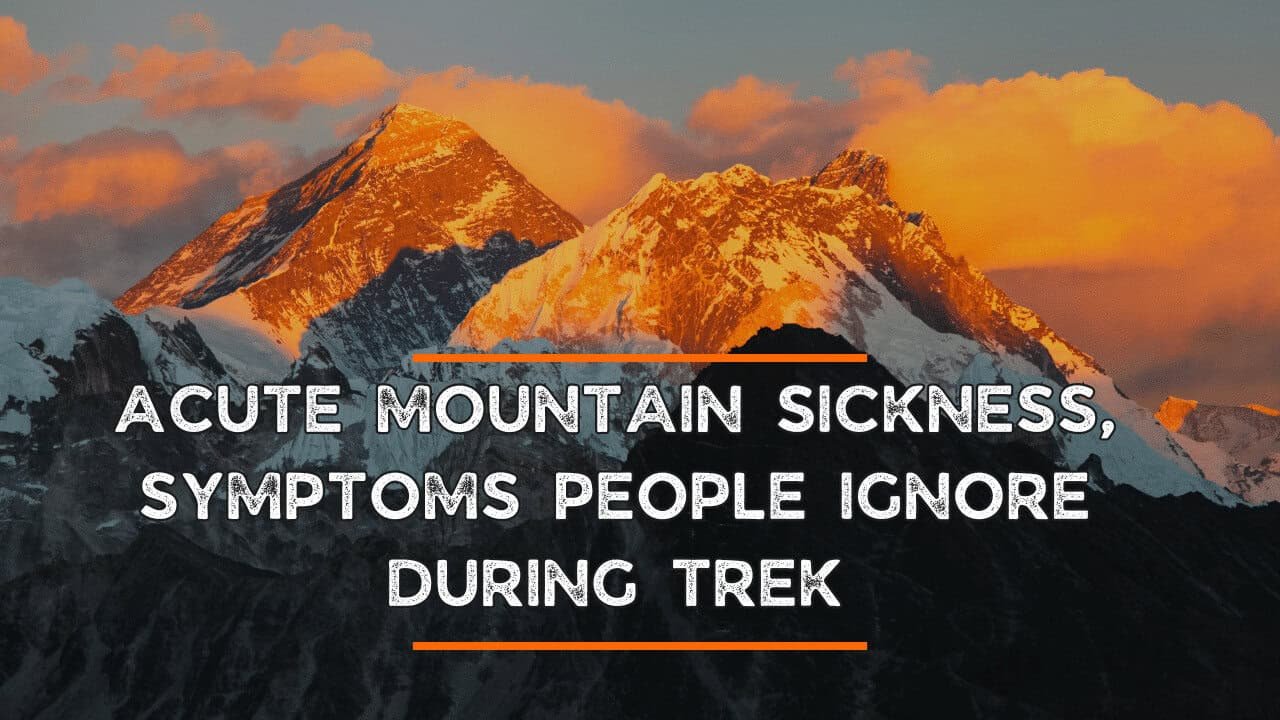
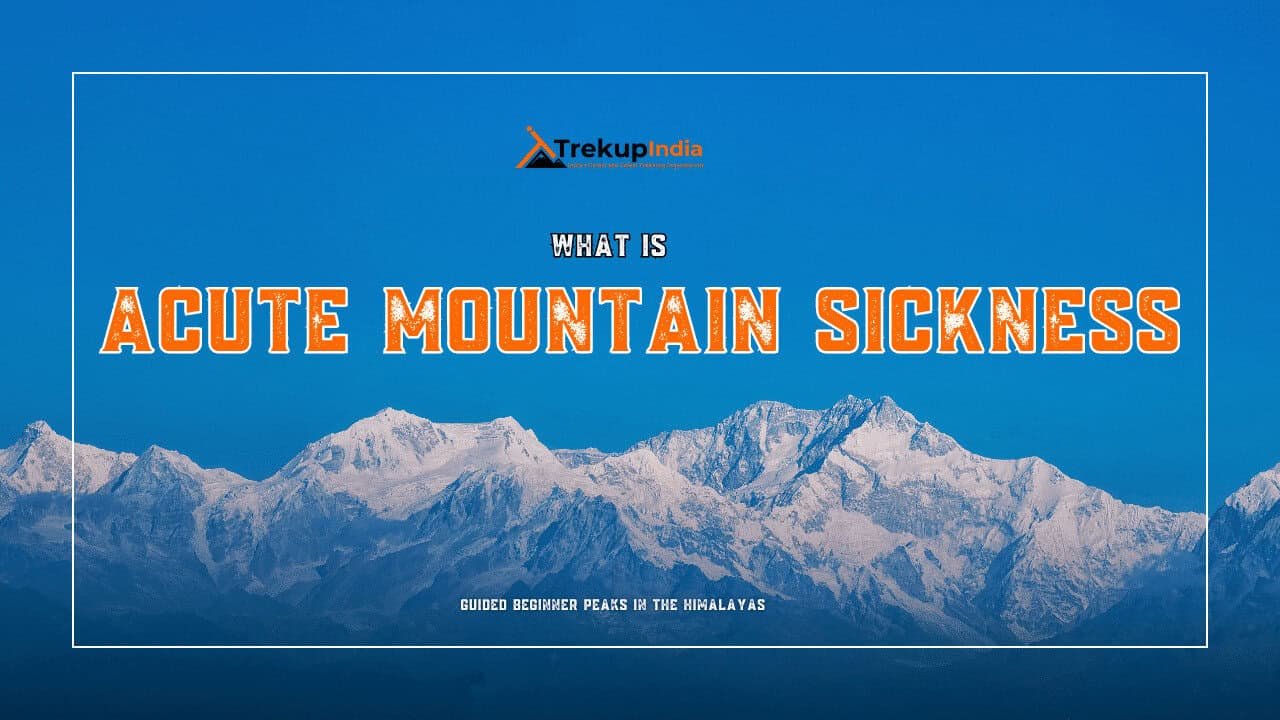
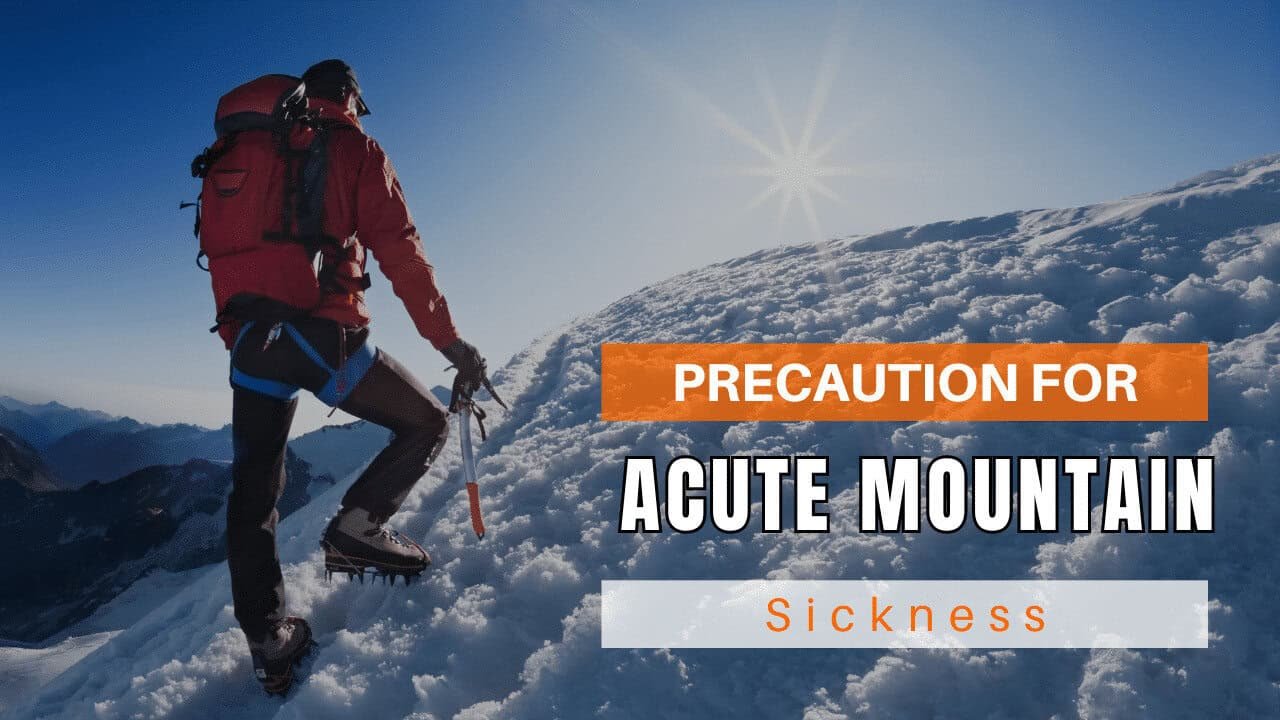
Day Wise Detailed Itinerary of Mt Jogin 3 Expedition
Here is a comprehensive plan for each day of this year’s Mt Jogin 3 Expedition. The schedule was designed to allow for proper acclimatization, logistical assistance, and plenty of time for climbing and descent.
Day 1: Arrival at Uttarkashi
- Goal: Get to the beginning point of the journey.
- Activities:
- In Uttarkashi che,ck in to your hotel of choice.
- Take part in a discussion about the overview of the trip including safety guidelines, check the equipment.
- Drinking water and rest to ensure your body is ready to take on the high altitude that lies ahead.
Day 2: Uttarkashi to Gangotri
- Distance : About 100km drive
- The goal is to transfer to the holy Valley of Gangotri.
- Activities:
- Leave Uttarkashi at the early hours of the morning for a beautiful route towards Gangotri.
- Relax and enjoy the view as you ascend into the valley.
- In the afternoon, arrive and get settled in.
- At night, you can participate in the Ganga Arati – a sacred ceremony along the river, to get acclimatized and take in the culture.
Day 3: Acclimatization Day in Gangotri
- The goal is to Start the process of acclimatization and get to know the surrounding area.
- Activities:
- Take a day trip on gentle walks around Gangotri.
- Nearby sites include Surya Kund and Pandava Gufa (a well-known cave).
- Try slow and steady strolling to aid your body adapt to the change in altitude.
- Take advantage of the day to rest as well as hydration and light stretching.
Day 4: The trek starting from Gangotri towards Bhojkharak (3780 meters)
- Goal: Beginning your ascent and moving from the valley towards higher altitudes.
- Activities:
- Get up early to start your journey from Gangotri and gradually climb until Bhojkharak which is located at a height of 3780m.
- Take in the panoramic view and make frequent breaks to check your progress in acclimatization.
- The campsite is Bhojkharak to stay the night to ensure the best rest and relaxation after the day’s trek.
Day 5: Walk to Bhojkharak up to Kedar Tal Base Camp (4780 m)
- Objective: Establish your Base Camp at Kedar Tal.
- Activities:
- Continue climbing to Bhojkharak up to Kedar Tal, which lies at a height of 4780m.
- The relatively short distance permits you to concentrate on the altitude increase while enjoying the changing mountain landscape.
- Establish a Base Camp upon arrival; it will be the primary area to stage additional climbs.
Day 6: Acclimatization at Kedar Tal Base Camp
- The goal is to Make sure you are prepared with your body and your equipment to tackle the more difficult ascents.
- Activities:
- Acclimatize for the day at Base Camp.
- Set up and try climbing gear and equipment to prepare for the climb to Advanced Base Camp.
- Get together with your team members to discuss logistical aspects of the load ferry and specifics for carrying (porters are only with you up at Base Camp; High Altitude Porters are arranged for further when needed).
- Take advantage of this time to do moderate local hikes if the conditions permit.
Day 7: Transition - Kedar Tal Base Camp to Advanced Base Camp
- Goal: Learn about the load ferry system and increase your exposure to higher elevations.
- Activities:
- Use the load ferry to move the supplies between Kedar Tal Base Camp to the Advanced Base Camp (located around 5150m).
- When the equipment is removed After that, you can go back for Base Camp.
- The shuttle procedure assists your body in adapting to the demands of climbing at high altitudes.
Day 8: Shuttle Run - Base Camp to Advanced Base Camp and Back
- Goal: Continue to acclimatize and confirm how the logistics will be handled for the next move.
- Activities:
- Take a trip around Base Camp and Advanced Base Camp by using this load ferry.
- Get familiar with the routes and ensure that the equipment was safely delivered.
- Go back the Base Camp to rest and set up for the setting up of Advanced Base Camp. Advanced Base Camp in earnest.
Day 9: Establishment of Advanced Base Camp (5150 m)
- The goal is to Create an Advanced Base Camp as the base camp for future the higher camps.
- Activities:
- Trek up to Advanced Base Camp (located at 5150m) and set up a secure camp.
- Install sleeping platforms, store items, and perform last equipment inspections.
- Conduct a short acclimatization exercise to ensure that the participants are at ease in this high altitude.
Day 10: Logistics - Advanced Base Camp to Camp 1 (Load Ferry)
- Goal: Begin the process of moving important materials to the next stage.
- Activities:
- Make use of the load ferry move the supplies between Advanced Base Camp to Camp 1.
- Once you have unloaded, go back to the Advanced Base Camp.
- Make sure that all arrangements are in place to ensure an easy transition the next day.
Day 11: Trek to Camp 1 (5470 m)
- Goal: Establish Camp 1 as the launchpad to push the summit.
- Activities:
- The ascent begins From Advanced Base Camp to Camp 1 currently at 5470 m.
- Create a camp and prepare the supplies. Make sure you have a comfortable and secure base for the following phase.
- Make use of the afternoon time to rest and hydrate before making your some final preparations to prepare for the next camps.
Day 12 : Load Ferry from Camp 1 to Summit Camp (Preparation Day)
- Goal: Get ready for the final ascent by carrying the equipment needed and opening the technical path.
- Activities:
- Make use of the load ferry in order to transport essential equipment between Camp 1 to the designated Summit Camp area.
- Return to Camp 1 following the ferry has run.
- The remainder of the day looking over the plan, which includes the technical section of the ice wall as well as making any needed changes.
Day 13: Establishing Summit Camp (5780 m)
- Goal: Establish Summit Camp and finalize the routes for the summit climb.
- Activities:
- From Camp 1 to the Summit Camp re,ach an elevation of 5780 m.
- Set up camp and arrange equipment.
- Unlock a 500-meter length of the path (including the possibility of portions of ice walls) in order to identify the path for the summit pushing.
- Retire and ensure that team members are properly briefed about the summit’s strategy.
Day 14: Summit Day - Mt Jogin III and Optional Summit of Jogin I
- Goal: Reach the summit at Mt Jogin III (6116 meters) with the option to proceed up to Jogin I (6456 meters) If conditions permit.
- Activities:
- Start the summit push from 2:00 am starting from Summit Camp.
- The climb will take you towards Mt Jogin III (6116 meters) For teams who wish to continue the climb proceed towards Jogin I (6456 meters).
- Once you have reached at the summit(s) and enjoying your accomplishment, head back into Camp 1 for an overnight rest.
Day 15: Descend From Camp 1 to Base Camp (Kedar Tal)
- Goal: Start the descent by taking steps back to lower elevations without danger.
- Activities:
- Take a break at Camp 1 and trek back towards Kedar Tal, the Base Camp at Kedar Tal.
- Make use of the descent time to reflect on your accomplishments at the summit and assist your body to recover from effort.
Day 16: Trekking to Kedar Tal to Bhojkharak
- Goal: Continue to descend towards the valley by moving away from Base Camp to Bhojkharak.
- Activities:
- The descent begins From Kedar Tal to Bhojkharak along the well-established route.
- Take advantage of the changing scenery with the decrease in altitude and the terrain becomes familiar.
Day 17: Trekking to Bhojkharak to Gangotri
- The goal is to Finish the last leg of the trek and return to Gangotri.
- Activities:
- The trek begins starting from Bhojkharak all the way to Gangotri by following the same route which you started on.
- In the evening, check into the local hotel to rest and relax.
Day 18: The departure from Gangotri
- Goal: Finish the adventure and then return to civilisation.
- Activities:
- After breakfast, you’ll be able to check-out at the Gangotri hotel.
- Transfer to the location for departure to begin your next travels, marking the completion of this Mt Jogin III Expedition.
The extensive itinerary has been designed to ensure strenuous climbs are balanced with sufficient acclimatization to ensure that everyone in the group is prepared for the demands of mountaineering at high altitudes. Enjoy your trip and be safe!
We’ve prepared a comprehensive Trek Route Map for your upcoming adventure to Mt Jogin III Expedition, which outlines the entire journey including all stops and trails. This map provides detailed information on the terrain, distance between points of interest, and estimated travel time to help ensure a safe and enjoyable trek. We’ve carefully curated the map to ensure that you have all the necessary information at your fingertips. Please take a moment to review it thoroughly, and don’t hesitate to reach out if you have any questions or concerns.
The Trek Altitude Chart is a useful tool for Trekkers to monitor their altitude changes during their rides, allowing them to plan their routes more efficiently and track their progress over time. This Mt Jogin III Expedition chart is beneficial for both casual and experienced Trekkers, helping them make the most out of their Trek experience.
Trek Cost Inclusions
- Stay: 13-15 Nights of tented accommodation at individual campsites of Trekup India on twin sharing. and 2 Nights hotel at Gangotri.
- Meals: Trekup India will provide freshly cooked meals during the trek starting with Lunch on Day 1 to Lunch on day 18 (Meals are simple, nutritious, and vegetarian)
- Transport: Dehradun to Gangotri and return at extra cost on sharing basis.
- Trek Insurance (Optional) – (At extra cost) : Trekup India recommends that all trekkers consider getting trek insurance. This is optional, but highly recommended. Trek insurance covers unexpected events that may occur during your trek. The cost of the insurance starts from INR 210. Please read more about what is included in the coverage and why it is mandatory on treks.
- Trek Equipment: Sleeping bag, Sleeping tents, Kitchen tent, Dining tent, Toilet Tent.
- Amenities: All utensils, sleeping mattresses (Black foam mats), Crampons, and Gaiters for snow.
- Health & Safety: First Aid Box, Oxygen Cylinders, Stretchers, Oxi meters, BP Machines, health.
- Permits: Forest Permits and Camping Permission Fee
- Trek Crew: High Altitude Chef, Helpers, Trek Leader & Guides, and other support teams.
- Potters & Mules: Potters and Mules are to carry all trekking equipment, ration, and vegetables.
Trek Cost Exclusions
- GST 5% (it is Mandatory)
- Any Meals/accommodation beside the itinerary or not mentioned in the program.
- Any Bus / Airfare to/from trek start/end point
- Personal Medical expenses do carry your medication.
- Any personal services such as Laundry, phone calls, liquors, mineral water, etc.
- Any still / video camera fee
- Any Entrance fee Monuments, Monasteries, Museums, Temples – Pay directly on the spot.
- Mules or porter charges to carry private baggage.
- Any emergency evacuation charges
- Any services that are not mentioned in the cost inclusion section.
What should you pack for the Mt Jogin 3 Expedition
Mt Jogin 3 Expedition is a high-altitude trek. The trekking gear you have to have for this particular trek differs from normal treks. Thus, read this whole segment. There is an important question that the trekker who is doing trek asks, like what all things to carry while trekking. Below, we have provided the details on everything you should take; an easy way to remember is by Head to foot or foot to head. We have prepared from Head to foot.
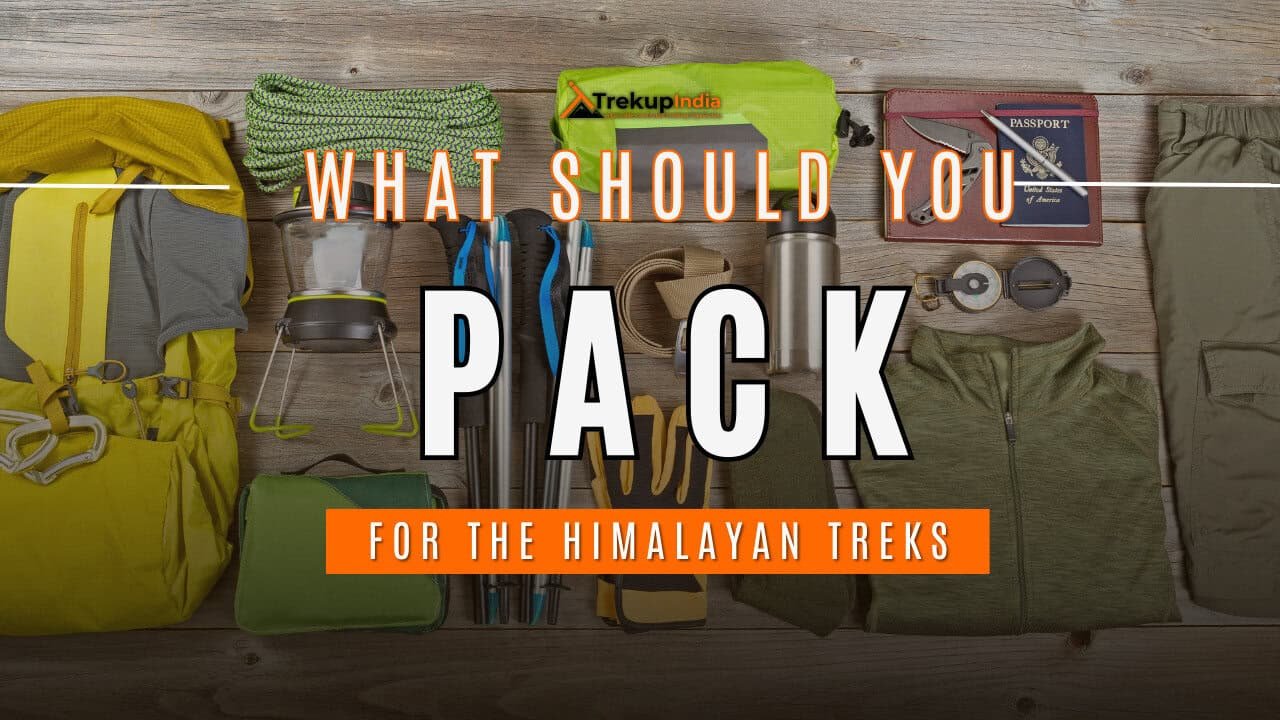
Head Gears
When trekking it's important to carry headgear to protect your head and face.
Heading out for a trek? Don’t forget to carry headgear to protect your beautiful face and head from the sun, wind, and dust! It’s an essential accessory that keeps you safe and comfortable throughout your adventurous journey. So, make sure you pack it before you step out into nature!
- Head Lamps – When trekking at night, headlamps are essential to illuminate your path while keeping your hands free. Headlamps come in different sizes and lumens, so it is essential to choose one that suits your needs.
- Hats or Cap – Caps or hats are also necessary when trekking in different weather conditions. Caps protect your head from the wind and freezing temperatures at night, while hats provide shade and protection from the sun during the day. It’s essential to ensure that your hat has a strap to prevent it from being blown away by the wind.
- Sunglasses – Sunglasses are also essential for trekking. Your sunglasses should protect your eyes from harmful UV rays and fit your face perfectly to avoid falling off while climbing, jumping, or crossing obstacles. The glass of your sunglasses should also be designed for different weather conditions to provide optimal visibility.
- Buff / Balaclava – Lastly, a buff or balaclava is a must-have to protect your mouth or neck from extreme temperatures and keep them warm. Buffs and balaclavas come in different materials, thicknesses, and designs, so it’s important to choose one that suits your needs and preferences. Depending on the weather conditions and your activities, you can wear them as neck warmers, face masks, or headbands.
Clothes
When trekking in high altitudes, prepare for cold weather by wearing layers. Layering traps heat, keeps you warm, and allows you to easily adjust your clothing as temperatures fluctuate.
Layering is important for different seasons when trekking. When planning a high-altitude trek, it is important to prepare for the cold weather. Wearing layers is the best approach as it provides both protection and flexibility when the weather changes frequently in the mountains. Layering helps to trap heat and keep your body warm, while at the same time allowing you to easily adjust your clothing as the temperature fluctuates. By wearing layers, you can enjoy your trek comfortably and stay safe in the unpredictable mountain weather
- For spring, summer, and monsoon treks, consider wearing three layers: a woollen sweater, a fleece, and a padded jacket.
- For autumn treks, add one more fleece layer to make it four layers.
- For winter treks, you may need five layers with thermals, a woollen sweater, two fleeces, and a padded jacket.
- T-shirt/sleeve shirt– Bring three T-shirts and two quick-dry trek pants, wearing one and carrying the others. Long sleeve shirts help to protect from sun UV rays. We recommend synthetic T-shirts as they get dry quickly when they get wet.
- Hiking / Trekking Jacket– down jackets (-5 to-10 C) or two-three-layer jackets.
- Thermals– at least two pairs of thermals help keep the body warm during cold weather.
- Undergarments– you can carry them according to your habitual and hygiene requirements.
- Gloves– 1 pair of gloves will keep your hand warm and nice.
- Trek Pants– Bring 2 to 3 comfortable trekking pants. Trekking pants play a significant role, as they are designed for comfort and mobility, making trekking easier. It should be Synthetic so that it gets dry quickly when wet.
- Rain Wear– you can carry a raincoat or Poncho. During long rains and snowfalls, the waterproof jackets start leaking. Still, the Poncho and raincoats keep you dry, so choose accordingly.
Tip: If you choose a raincoat on your trek, carry a small waterproof cover so things inside your backpack can’t get wet. If you carry a Poncho, you don’t need to worry. It protects both you and your backpack.
Foot Gears
When it comes to planning a trek, one of the most important aspects is to ensure that you have the right kind of foot gear.
- Trekking shoes which are waterproof and have ankle support. Walking / Hiking sandals which can be used off the trek, i.e., in the morning and evening hours when you reach the campsite, basically to get your feet rest from heavy boots, sometimes used for crossing streams and rivers, it’s more comfortable and safer than crossing barefoot or wetting your shoes. Sneakers (Optional) can be worn for normal driving days or used around the camp.
- Socks– you should at least carry 3 to 4 pairs.
- Microspikes & Gaitorswill be provided by Trekup India when required. You don’t have to carry them.
Personal First Aid Kit
Don't forget to pack your personal first aid kit! It's always better to be safe. So, make sure you're prepared for any unforeseen circumstances.
Below are some common medicines generally required/used during your adventure trip; however, please consult your doctors prior.
- Antiseptic towel or water syringe (to clean the wound)
- Butterfly bandage for a small cut
- Cotton and elastic bandages and sterile gauze pad for larger wounds
- Latex gloves are used when the wound bleeds.
- Medicine for Diarrhea (Upset stomach)
- Medicine for cold, flue/fever, headache
- Some pain killers
- ORS pouches
- Quick pain relief spray (External use)
- Any personal medicine prescribed by your doctor
- Dimox / Similar for high altitude sickness
- Bug Repellent
- Carry some nutria/energy bars and drinks (non-alcoholic)
- Note: Kindly consult your doctor before purchasing or taking any medicine.
Gadgets and Other Items
You might also consider bringing a camera, binoculars, portable charger, and snacks. Be well-prepared and tackle any trail with confidence.
- Trekking Poles
- Mobile phone
- Camera
- Spare batteries for phone and camera, power bank
- Lightweight flashlight or headlight
- A waterproof bag made of plastic is used for the camera.
- Plug/converter for electrical items
- 1-litre water bottle
- A journal with a pen would be a good idea to keep your notes.
- Some book of your interest for the ideal time
- Get into the habit of maintaining a Map and guidebook of the region.
Hygiene & Personal toiletry
Remember to pack hygiene and personal toiletry items such as soap, shampoo, toothbrush, toothpaste, deodorant, and toilet paper.
- Sunscreen with UV protection to shield your skin from harmful rays
- 1 or 2 small quick-drying towels to help you dry off quickly in case of rain or sweat
- Toilet paper, tissues or wet wipes for maintaining hygiene while on the trek
- Toothbrush, toothpaste, and mouth freshener to keep your mouth clean and fresh throughout the journey
- Deodorant or talcum powder to help you stay fresh and odor-free, especially during hot and humid climates
- Shampoo to keep your hair clean and healthy
- Sanitary pads or tampons (for female trekkers) to manage menstrual cycles
- Lip-gloss or salve to protect your lips from dryness and chapping
- Bio-degradable soap to keep yourself clean and hygienic while on the trek
- Nail clipper and other personal items that you use daily
Compulsory Documents to Carry
There are certain documents that you should always carry with you. These documents are not only necessary for your safety and security, but they may also be required by local authorities.
These files must be submitted to the Forest Department before your trek. With none of these, you will not be permitted to trek—original and photocopy of government photo identity card. Carry IDs like Aadhaar, voter ID, etc.
How To Plan Your Trek & Reach Dehradun?
Dehradun is easily accessible by rail, air, and road.
By Air
- Jolly Grant Airport is located about 25 kilometers from the city centre. It is served by frequent flights from large Indian cities.
- Alternate airports: You can also travel to nearby cities such as Chandigarh and New Delhi, then take the bus or taxi to Dehradun.
By Train
- Dehradun Railroad Station: This station is easily accessible via direct trains to Delhi, Jammu, Chandigarh and, and other cities. It’s a pleasant and scenic alternative to reach Dehradun.
By Road
- Buses Many state—and privately owned buses travel between cities like Delhi, Chandigarh, and Shimla and direct to Dehradun.
- Driving: If you prefer driving, highways generally have good working order. For example, the trip to New Delhi (around 250 km) will take about 7 to 8 hours.
Fitness Required & Preparation Guide For Mt Jogin 3 Expedition
If you’re preparing for a Mt Jogin 3 Expedition, Trekup India recommends jogging as part of your fitness routine. Jogging helps work out the same muscle groups that you’ll use during trekking and can help you build endurance. You don’t need any special equipment to get started.
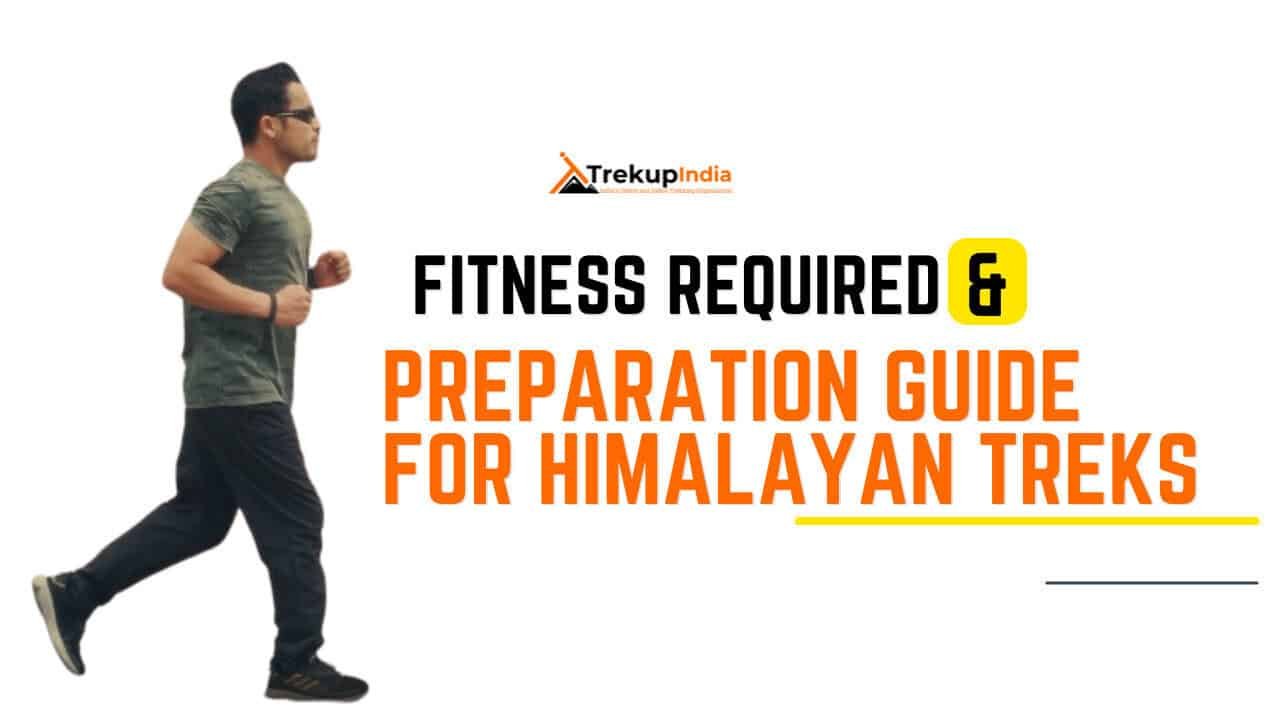
Fitness Target
Trekup India has put the Mt Jogin 3 Expedition into an easy-to-moderate-grade-level trek.
For Chanllenging Expeditions – In order to be well-prepared for your upcoming trek, it is recommended that you focus on building your endurance by aiming to cover a distance of 4.5 kilometers in less than 25 minutes. This will help you to develop the necessary stamina and strength required to successfully complete your journey.
How to Achieve This Fitness Target?
To start preparing for your trek:
- Try jogging for at least five days every week.
- If you find 4.5 km too difficult at first, begin with 2 km and gradually increase over 2-3 weeks.
- Once you feel more comfortable running 4.5 km, focus on improving your speed gradually on a daily basis.
It is important to ensure that you can consistently complete 4.5 km in under 45 minutes for at least two weeks before your planned trek. Allow yourself 6-8 weeks to prepare physically for the journey.
Strength Training exercises that benefit Trekking
Trekking is an activity that demands a good level of strength.
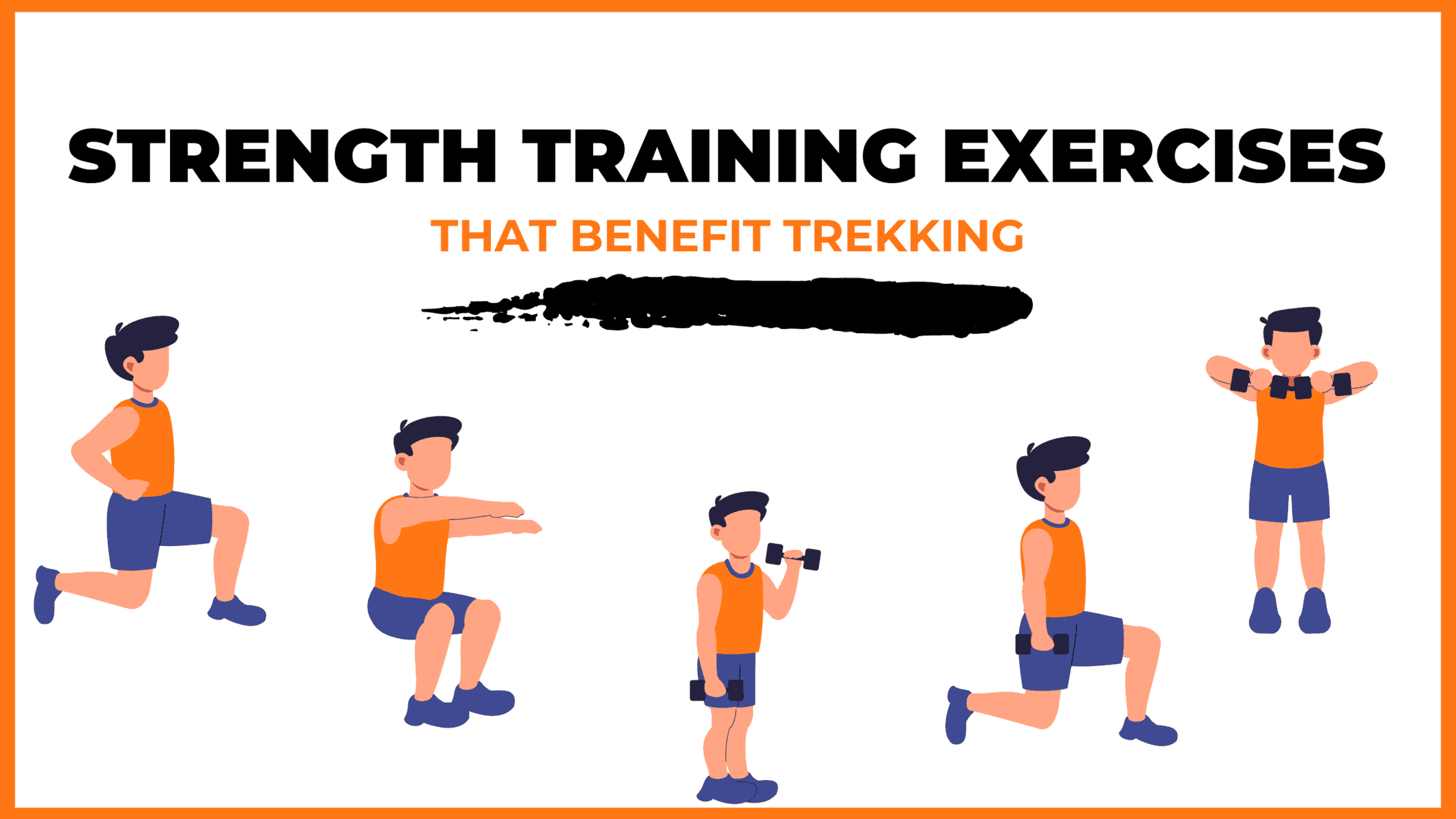
Trekking is a demanding activity that requires good cardiovascular endurance, muscular strength, and overall fitness. To help you prepare for your trek, incorporating bodyweight exercises into your training routine can be an effective way to build strength, improve stability, and enhance endurance, all of which are crucial for a successful trek. In this regard, here’s a breakdown of body weight exercises categorized by the specific body parts they target and the benefits they offer during trekking.
1. Lower Body Exercises
Lower body exercises like squats and lunges are great for building lower body strength, essential for trekking.
a. Squats
Squats are an excellent exercise for building lower body strength, essential for trekking. They target the quadriceps, hamstrings, glutes, and calves. Solid quadriceps and glutes provide power for ascending and tackling uphill climbs, while vital hamstrings aid stability during descents. This is particularly helpful in navigating uneven terrain during trekking.
How to perform Squats Exercises:
- Stand with feet shoulder-width apart, toes pointing slightly outward.
- Lower your body by bending your knees and hips, keeping your back straight.
- Lower until your thighs are parallel to the ground or as low as comfortable.
- Push through your heels to return to the starting position.
b. Lunges
Lunges target the quadriceps, hamstrings, glutes, and calves. They improve lower body strength, balance, and stability, crucial for maintaining control on rocky trails and steep slopes. Additionally, they enhance flexibility, reducing the risk of injury while trekking.
How to Perform Lunge Exercises:
- Stand with feet hip-width apart, hands on hips or sides.
- Take a step forward with one foot, lowering your body until both knees are bent at 90-degree angles.
- Push through the heel of your front foot to return to the starting position.
- Repeat on the other side, alternating legs.
2. Upper Body Exercises
Upper body exercises such as push-ups and pull-ups effectively strengthen the upper body, especially the chest and shoulders, which are essential for carrying a backpack during treks.
a. Push-Ups
Targets: Chest, shoulders, triceps, and core.
Benefits for Trekking: Push-ups are an effective exercise to strengthen the upper body, especially the chest and shoulders, essential for carrying a backpack during treks. Improved upper body strength will also help maintain posture and stability while traversing challenging terrain.
How to Perform Push-Ups Exercises:
- Start in a plank position with hands shoulder-width apart and body in a straight line from head to heels.
- Lower your body by bending your elbows until your chest nearly touches the ground.
- Push through your palms to return to the starting position.
- Keep your core engaged throughout the movement.
b. Pull-Ups/Bodyweight Rows:
Targeting the back, biceps, and shoulders can significantly benefit trekking. You can strengthen these muscle groups by performing pull-ups or bodyweight rows and improve your posture and balance while carrying a backpack. Additionally, more muscular back muscles can help reduce the risk of back strain and fatigue during long treks, making your journey safer and more comfortable.
3. Core Exercises
Core exercises like planks and Russian twists can help strengthen the core muscles, which are crucial for maintaining stability and balance while trekking on uneven terrain.
a. Planks
Targets: Abdominals, obliques, and lower back.
Benefits for Trekking: Planks are an effective exercise that helps strengthen the core muscles. These muscles are crucial for maintaining stability and balance while trekking on uneven terrain. A strong core also helps improve posture, reducing the risk of back pain and fatigue during extended hikes.
How to Perform Planks Exercises:
- Start in a plank position with elbows directly under shoulders and body in a straight line from head to heels.
- Engage your core and hold the position, avoiding sagging or arching the back.
- Keep breathing steadily and hold for the desired duration.
b. Russian Twists
Targets: Obliques, abdominals, and lower back.
Benefits for Trekking: Russian twists engage the core muscles, particularly the obliques, improving rotational stability and balance. Enhanced core strength helps prevent injuries and improves overall performance during trekking.
How to Perform Russian Twist Exercises:
- Sit on the ground with knees bent and feet flat, leaning back slightly to engage the core.
- Clasp hands together and twist the torso to one side, bringing the hands towards the ground beside the hip.
- Return to the centre, then twist to the other side.
- Continue alternating sides for the desired number of repetitions.
4. Full Body/Cardiovascular Exercises
Full-body/cardiovascular exercises like burpees and mountain climbers are excellent for improving cardiovascular endurance, strength, and agility.
a.Burpees
Burpees are an excellent full-body exercise that targets your legs, chest, arms, and core. This exercise dramatically benefits trekking enthusiasts, improving cardiovascular endurance, strength, and agility. Regularly incorporating burpees into your workout routine can enhance your overall fitness level, which can help you endure long hikes and rugged terrains with ease.
How to Perform Burpees Exercises:
- Start in a standing position.
- Squat down and place hands on the ground.
- Jump feet back into a plank position.
- Perform a push-up.
- Jump feet back to the squat position.
- Explosively jump up into the air, reaching overhead.
- Land softly and repeat the sequence.
b. Mountain Climbers
Mountain climbers target the core, shoulders, chest, and legs. This dynamic, full-body exercise can significantly improve cardiovascular endurance and agility. It is an excellent functional workout for trekking preparation as it engages both the upper and lower body muscles while strengthening the core muscles.
How to Perform Mountain Climbers Exercises:
- Start in a plank position with hands shoulder-width apart and body in a straight line from head to heels.
- Drive one knee towards the chest, then quickly switch legs, alternating in a running motion.
- Keep the core engaged and the hips stable throughout the movement.
- Continue at a moderate to fast pace for the desired duration.
Incorporating bodyweight exercises into your training routine can help you build strength and endurance and prepare your body for the physical demands of trekking. Consistency and proper form are crucial to maximizing the benefits of these exercises and ensuring a safe and enjoyable trekking experience. Engaging your core muscles, including obliques, abdominals, and lower back, with Russian twists can improve your rotational stability and balance, preventing injuries and enhancing overall performance during trekking.
When incorporating strength training exercises into your workout routine, it’s essential to maintain proper form and technique to avoid injury. Start with lighter weights and gradually increase the intensity as you progress, focusing on compound exercises targeting multiple muscle groups simultaneously. Some examples of practical strength training exercises for trekking include squats, lunges, deadlifts, and pull-ups.
Remember to give your muscles time to recover between workouts, and remember to stretch before and after your workouts to prevent injury and improve flexibility. Combining strength training with jogging and proper stretching allows you to take your fitness to the next level and confidently tackle even the most challenging treks.
Our Trekkers Reviews And Expreinces
We provide only Indian vegetarian food, and your meal will mainly consist of Indian bread, vegetables, lentils, rice, and a delicious dessert. During your trek, we will serve three meals a day, including breakfast, lunch, and dinner. You will also be served tea, snacks, and lip-smacking soup in the evening before dinner. If it is a long day of trekking, you will be given a packed snack.
After extensive research on the trekkers’ nutritional requirements, we prepare the menu. Before putting all the meals together, we also consider the altitude and the weather.
The meal we serve during the trek is perfectly balanced with calories, carbohydrates, vitamins, protein, fibre, and minerals. You need to know that all our cooks have great expertise in cooking and have undergone thorough training. So, get ready to enjoy delectable and lip-smacking dishes during your trek. You will be served with lemon tea in the tent to start your day with a refreshed feeling. Before leaving the campsite for trekking, you will be given a hot finger-licking breakfast like upma, Aallu Prantha, Besan Chilla, Poha, Daliya, Corn flakes, and Maggie, along with tea or coffee.
If your trek is longer, we also offer some fresh local fruits such as apples and healthy drinks like Frootie or Maaza. In the afternoon, you will be served a simple & healthy lunch, while at around 04:00 pm, you will be given tea and a light evening breakfast. After you reach your campsite at night, you will be served a hot and delightful dinner.
After reading this, you must have understood the food we provided on the trek; you don’t need to worry about food. Many trekkers repeatedly trek with us because of the food we provide. Thus, we will give you unforgettable experiences.
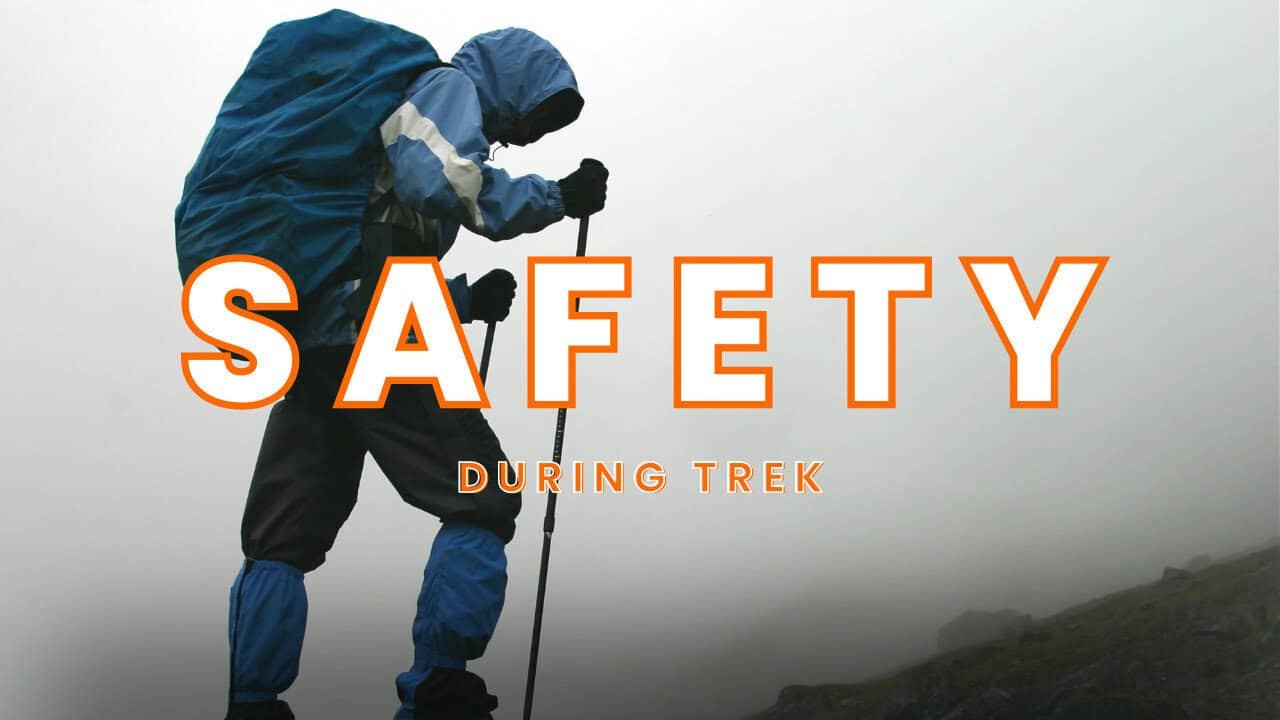
Trekking with us for the Mt Jogin 3 Expedition is entirely safe because we have a team of trek leaders qualified in Wilderness first-aid and complete information about the high-altitude glitches. During the trek, we carry a full first-aid kit that contains all the essential medicines. Before trekking with us, you must ensure that you are medically fit for the trek; for us, your medical fitness is more important than anything else.
Right from our establishment, we at Trekup India have been continuously introducing new safety practices into Indian trekking to ensure the safety of voyagers. Trekup India introduced microspikes and made emergency bottled oxygen mandatory for all treks. Our trek leaders take your daily Pulse oximeter reading. We at Trekup India introduced the radio walkie-talkie as a safety communication device.
How can we ensure that your trek is safe with us?
We have noticed that most trek-organizing organizations do not follow these systems, but with time, they are following us; several competing companies are adopting these practices and organizing great, safe treks.
We ensure complete technical safety in the mountain. Our company has a vast team of more than 100 guides and trek leaders who serve on Himalayan treks. One of the best things about our team is that all the members are trained professionally by the Nehru Institute of Mountaineering, Indian Mountaineering Foundation Delhi, and Hanifle Center Outdoor Education Mussoorie.
Explore our New Safety Protocols
To ensure a perfect Trek, we have introduced some new safety checks to ensure excellent safety for our trekkers.
Our On-trek safety checks include:
- Daily oxygen saturation, along with pulse readings
- Stretchers team appointed on every trek
- Radios
- Trained mountain staff and complete safety
- Additional oxygen cylinders
- Special medical kit for high-altitude treks
- Microspikes on all types of snow treks
- Experienced Trek leaders, as well as safety
- Technical team on all snowy slopes
For Us, Your Safety Is the Top Priority
At Trekup India, you will find a team with local knowledge and fluency in English and Hindi. This helps ensure that you have a fantastic trek. Not only this, but we also pay attention to your health and safety because this is something we cannot ignore. All the team leaders involved in trekking have already undergone several professional courses in first aid, portable altitude chamber training, CPR, environmental awareness training, and advanced wilderness emergency medicine.
We also carry a complete first aid medical kit on every trek and trip we organize. Apart from the medical kit, we take a portable altitude chamber (if needed) and medical oxygen for all high-altitude treks. Our company has significant expertise in organizing all sorts of group adventure holidays for family groups, school and college groups, and friend groups. We have many travel options that suit different fitness levels and travelling styles.
Regardless of the group size, we value each and every member of our trekking groups. Our commitment to personal attention ensures that your needs and safety are always our top priority.
Who we are?
Trekup India has been a stalwart in the Adventure Tourism industry for 30 years. Since our inception, we have been dedicated to providing top-notch treks, voyages, trekking programs, and high-altitude expeditions. Our extensive experience is a testament to our commitment to your adventure and safety.
We organize treks in Uttarakhand, Kashmir, Sikkim, and Himachal while being part of the trekking community; we feature more than 75 documented Himalayan treks. In addition to other outdoor activities, our company also organizes trips for schools, colleges, and families.
Therefore, we maintain the quality of services offered to our valuable customers.
Frequently Asked Questions About Mt Jogin 3 Expedition
Is Prior Trekking Experience Necessary for the Mt Jogin III Expedition?
A previous trekking experience is highly recommended to participate in the Mt. Jogin 3 Expedition. Jogin 3 Expedition is an technically challenging, high-altitude hike within the Garhwal Himalayas which reaches around 6116 m (20,062 inches). This is why previous experiences are essential:
1. High Altitude and Acclimatization
- The trek takes you over 6000 meters in altitudes where oxygen levels are considerably less.
- If you don’t have previous experience with high altitude treks There is a greater risk of acute Mountain Sickness (AMS), which is a risky condition.
- An experienced trekker is familiar with appropriate acclimatization strategies for adjusting to the extreme heights.
2. Technical Climbing Skills
- Jogin 3 is a challenging climb. Jogin 3 Peak includes glacier traverses, difficult ascents and sections that call for the making use in the form of climbing ropes and crampons Ice axes as well as harnesses.
- Though it’s far from the most technically-advanced mountain, basic mountaineering skills are essential.
- The experience of trekking across the snow, ice or the surfaces of rocks is beneficial.
3. Physical Endurance and Fitness
- This challenge demands an excellent endurance of the heart power, stamina, and strength.
- It is essential for trekkers to endure long periods of constant trekking (6-10 hours per every day) with a loaded backpack.
- An experience with multiple-day hikes (preferably at or above 4,500m) will help build the required endurance.
4. Experimentation with extreme weather conditions
- At high altitudes, weather conditions can be unpredictable–expect sub-zero temperatures, strong winds, and snowfall.
- Previous experience with these situations helps trekkers be mentally and physically fit.
Recommended Prior Experience
- At least one or two high-altitude treks (above 4,500-5,000 meters), such as Kedartal, Rupin Pass, Goechala, or Pangarchulla Peak.
- A basic understanding regarding mountaineering equipment and methods.
- A Mountaineering class (optional however beneficial) from an institute such as HMI or NIM HMI could be beneficial.
Final Verdict
If you’re an experienced hiker seeking to make the transition to climbing, Jogin 3 is the ideal alternative–but having prior high altitude trekking experiences are essential. If you’re a beginner, it’s recommended to begin by doing several shorter climbs in high altitude as well as basic mountaineering classes prior to climbing this mountain.



